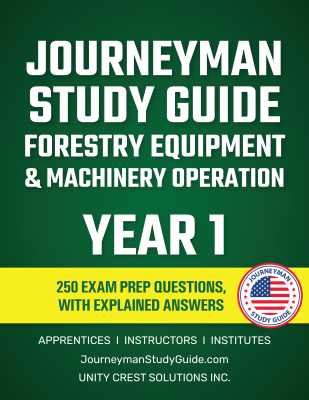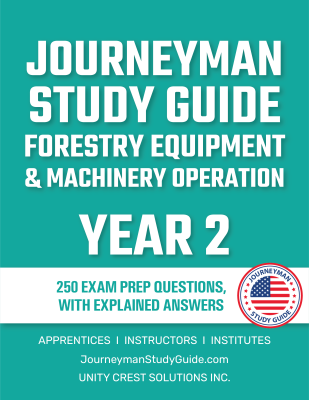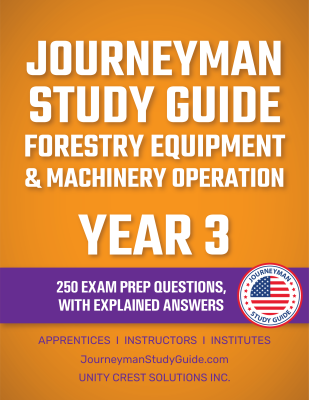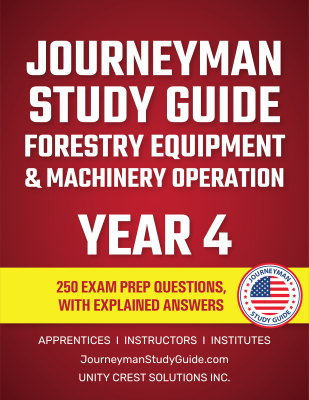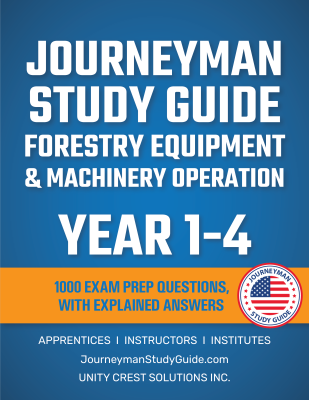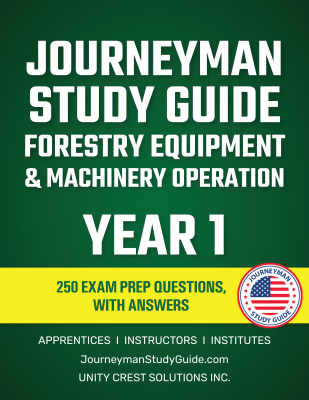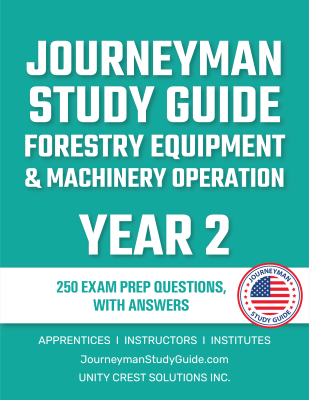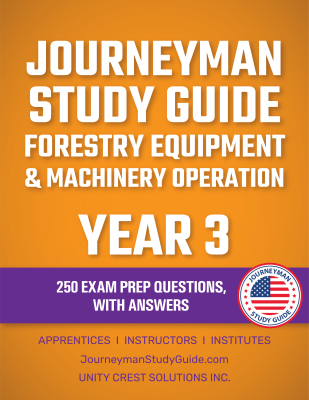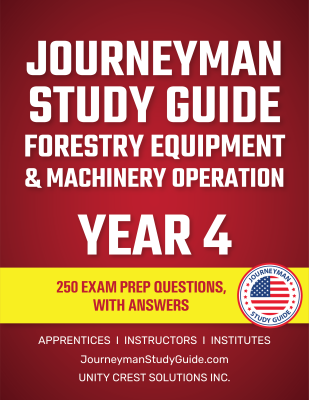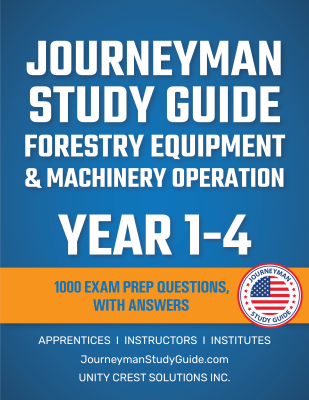Questions, Answers, & Explanations
Get clear explanations behind every answer, perfect for deeper learning and more thorough exam preparation.
Site Updates in Progress: Things might look different as we work on enhancing your experience.
What is a Forestry Equipment & Machinery Operator?
Forestry Equipment & Machinery Operators are skilled professionals responsible for operating heavy machinery used in logging, land clearing, and forest management. These operators work with harvesters, skidders, feller bunchers, loaders, and mulchers to safely and efficiently process timber while following environmental and safety regulations.
Their work is essential to sustainable forestry practices, ensuring that timber harvesting and land management are done responsibly. Operators work in private logging companies, federal and state forestry services, and commercial land development projects.
Key Responsibilities
Forestry Equipment & Machinery Operators perform a variety of technical and physically demanding tasks in the field, including:
Skills and Traits for Success
Forestry equipment operators must possess a strong mechanical understanding, attention to safety, and the ability to work in rugged outdoor environments:
Industries Where Forestry Equipment Operators Thrive
Forestry machinery operators play a critical role in several industries, including:
Why Choose This Career?
A career as a Forestry Equipment & Machinery Operator offers stability, competitive wages, and the opportunity to work outdoors in diverse landscapes:
✅ Strong Demand – The U.S. forestry industry relies on skilled operators for sustainable logging and wildfire prevention efforts.
✅ Competitive Pay – Certified operators earn excellent wages in private logging firms and government forestry programs.
✅ Hands-On Work – Ideal for individuals who enjoy working outdoors with powerful machinery.
✅ Career Advancement – Operators can specialize in high-demand fields like land clearing, wildfire management, or heavy equipment maintenance.
Ready to Start Your Career in Forestry Equipment & Machinery Operation?
Prepare for certification and career success with our study guides, Q&A products, and interactive online tests designed for Forestry Equipment Operators.
What to Expect on the Forestry Equipment Operator Certification Exam
The Forestry Equipment Operator Certification Exam ensures that operators meet U.S. industry safety and operational standards for running heavy forestry machinery. Many employers in logging, land clearing, and wildfire prevention require certification as proof of skill in equipment operation, maintenance, and safety compliance.
State forestry agencies, private logging companies, and unions like the International Union of Operating Engineers (IUOE) recognize certified operators as skilled professionals in the field.
Exam Format
The certification exam evaluates both theoretical knowledge and practical skills in forestry equipment operation. Here’s what you can expect:
Key Topics Covered in the Exam
1. Safety and Workplace Practices
2. Forestry Equipment Operation
3. Equipment Maintenance and Troubleshooting
4. Land and Environmental Management
5. Mathematical Applications in Forestry Equipment Operation
Passing Requirements
Most certifying bodies require a minimum score of 70% to pass the written exam. Some states and employers also require a practical hands-on assessment, where operators must demonstrate:
✅ Safe operation of heavy forestry equipment.
✅ Ability to handle emergency shutdowns and hazard avoidance.
✅ Understanding of forestry environmental regulations and BMPs.
Tips for Preparing Effectively
Ready to Pass Your Forestry Equipment Operator Exam?
Prepare for certification and career success with our study guides, detailed Q&A explanations, and interactive online tests tailored for Forestry Equipment Operators.
What Types of Questions Are on the Forestry Equipment Operator Certification Exam?
The Forestry Equipment Operator Certification Exam assesses an operator’s knowledge of logging techniques, safety standards, and equipment handling. The test includes a variety of question formats designed to evaluate real-world problem-solving skills and forestry operations knowledge.
Common Question Formats
1. Multiple-Choice Questions
2. Scenario-Based Questions
3. Calculation-Based Questions
4. Equipment and Component Identification
Sample Questions
1. Safety and Workplace Practices
Question: "Which piece of personal protective equipment (PPE) is required for operating a chainsaw in logging operations?"
2. Forestry Equipment Operation
Question: "What is the primary function of a feller buncher?"
3. Equipment Maintenance & Troubleshooting
Question: "If a hydraulic system on a Tigercat skidder is losing pressure, what is the most likely cause?"
4. Land and Environmental Management
Question: "Which forestry practice helps reduce soil erosion after timber harvesting?"
5. Math for Forestry Equipment Operators
Question: "A log is 20 feet long and has a diameter of 3 feet. Using the Scribner log rule, how many board feet can be produced?"
Tips for Answering Exam Questions
Want More Practice?
Access hundreds of practice questions, detailed explanations, and interactive tests tailored for Forestry Equipment Operators. Improve your confidence and ensure success on exam day.
What Is It Like to Work as a Forestry Equipment & Machinery Operator?
The daily life of a Forestry Equipment & Machinery Operator is fast-paced, physically demanding, and essential to sustainable forestry, logging operations, and land management. These professionals work in heavily wooded areas, sawmill yards, and remote forestry sites, using powerful machinery to fell trees, transport logs, clear land, and maintain forest health.
Operators must be highly skilled in handling heavy equipment, following OSHA logging safety regulations, and adapting to changing weather and terrain conditions. Work schedules can range from day shifts to overnight operations, depending on the project and industry demands.
Morning: Preparing for the Job
The workday starts early, typically around 6:00 or 7:00 AM, with safety checks and job planning:
Midday: Logging, Land Clearing, and Timber Processing
The majority of the workday is spent operating heavy machinery in forested areas, sawmill yards, or land clearing projects:
Afternoon: Equipment Maintenance and Job Site Cleanup
As the workday ends, operators focus on machine maintenance, safety checks, and preparing for the next shift:
Challenges and Rewards of Forestry Equipment Operation
✅ Challenges:
✅ Rewards:
Ready to Start Your Forestry Equipment Career?
Prepare for certification and career success with our study guides, Q&A products, and interactive online tests designed for Forestry Equipment Operators.
What Are the Long-Term Benefits of a Career as a Forestry Equipment Operator?
Forestry Equipment Operators enjoy strong wages, stable employment, and career advancement opportunities. Whether working for private timber companies, land clearing contractors, or state forestry agencies, skilled operators can specialize, gain leadership roles, or even start their own forestry businesses.
Earning Potential for Forestry Equipment Operators
Salaries vary by experience, industry, and location:
1. Entry-Level (Apprentice or Junior Operator)
2. Experienced Journeyman Operator
3. Supervisory or Specialized Roles
Regional Salary Differences
Career Growth Opportunities
1. Specialization in Advanced Forestry Equipment
2. Transition into Supervisory and Management Roles
3. Union Membership Benefits
4. Business Ownership and Independent Contracting
The Benefits of Forestry Equipment Certification
✅ Higher Pay – Certified operators earn more than non-certified workers.
✅ Job Security – The demand for skilled forestry workers continues to grow.
✅ Career Advancement – Certification leads to better job opportunities in land management and sustainable forestry.
Ready to Advance Your Forestry Equipment Career?
Prepare for certification and career success with our study guides, Q&A materials, and interactive online tests tailored for Forestry Equipment Operators.
How Much Can You Earn as a Forestry Equipment Operator?
Forestry Equipment & Machinery Operators earn competitive wages based on experience, specialization, and location. Whether working in logging, land clearing, wildfire prevention, or timber harvesting, skilled operators are in high demand across the United States.
Certification and union membership can increase wages and provide additional benefits, such as health insurance, pensions, and job security.
General Wage Ranges for Forestry Equipment Operators
1. Entry-Level (Apprentice or Junior Operator)
2. Certified Journeyman Forestry Equipment Operator
3. Supervisory or Specialized Roles
Regional Salary Differences
Salaries vary by state and demand for forestry operations:
Factors That Impact Wages
1. Certification Level
2. Union Membership
3. Equipment Specialization
4. Industry and Employer Type
Want to Boost Your Earning Potential?
Advance your career with our study guides, Q&A products, and interactive online tests to enhance your skills and increase your earning power.
What Tools and Resources Do Forestry Equipment Operators Need to Succeed?
Forestry Equipment & Machinery Operators rely on heavy machinery, precision tools, and industry resources to safely and efficiently manage logging, land clearing, and forest maintenance tasks. Whether working in commercial timber harvesting, wildfire prevention, or private land management, having the right tools is essential.
Essential Tools for Forestry Equipment Operators
1. Heavy Equipment and Logging Machinery
2. Diagnostic and Maintenance Tools
3. Safety and Personal Protective Equipment (PPE)
4. Measuring & Marking Tools
Recommended Learning Resources for Forestry Equipment Operators
1. Study Guides and Certification Prep
2. Trade Associations and Industry Organizations
3. Forestry Schools and Technical Colleges
4. Manufacturer Training Programs
Why the Right Tools and Training Matter
✅ Efficiency – Proper tools increase work productivity and precision.
✅ Safety – Using industry-approved safety equipment reduces injury risk.
✅ Career Advancement – Advanced training leads to higher-paying roles in forestry operations.
Looking for the Best Study Materials?
Prepare for certification and career success with our study guides, Q&A products, and interactive online tests designed for Forestry Equipment Operators.
Where Can You Learn Forestry Equipment Operation?
Becoming a Forestry Equipment & Machinery Operator requires hands-on training, classroom education, and certification in equipment safety and environmental regulations. Operators are trained to handle logging machinery, perform maintenance, and follow sustainable forestry practices.
Education programs are available through apprenticeships, vocational schools, technical colleges, and manufacturer training programs. Many programs partner with logging companies, timber mills, and government forestry agencies, ensuring that graduates gain real-world experience.
Types of Forestry Equipment Training Programs
1. Apprenticeship Programs
2. Technical and Vocational Schools
3. Manufacturer-Sponsored Training Programs
4. State and Federal Forestry Programs
What to Expect in a Forestry Equipment Training Program
1. Core Topics Covered:
2. Hands-On Training:
3. Certification Preparation:
How to Choose the Right Forestry Equipment Program
✅ Accreditation – Ensure the program is recognized by state forestry agencies and logging industry leaders.
✅ Industry Partnerships – Look for programs linked to major forestry employers and equipment manufacturers.
✅ Location – Select schools near major logging operations and forestry management sites.
✅ Financial Aid – Many programs offer grants, scholarships, and employer-sponsored tuition.
Why Education Matters for Forestry Equipment Operators
✅ Job Security – Trained operators are in high demand across the U.S..
✅ Higher Wages – Certification leads to better salaries and job opportunities.
✅ Career Growth – Education allows for advancement into forestry management and specialized equipment roles.
Ready to Start Your Forestry Equipment Career?
Get started with our study guides, certification resources, and interactive practice exams to become a top Forestry Equipment Operator.
Why Join a Union or Connect with Employers?
Forestry Equipment Operators who join unions and reputable employers benefit from higher wages, job security, and career advancement opportunities. Unions provide specialized training, legal representation, and safety advocacy, while top employers offer steady work and long-term career growth.
Benefits of Joining a Union
1. Higher Wages and Benefits
2. Job Security
3. Advanced Training Opportunities
4. Workplace Representation
Top Unions for Forestry Equipment Operators
Connecting with Employers
1. Types of Employers for Forestry Equipment Operators
2. What Employers Look For
3. How to Stand Out in the Forestry Job Market
4. Utilize Online Job Boards
Why Unions and Employers Matter for Forestry Operators
✅ Secure Employment – Union and government jobs provide stable careers.
✅ Higher Pay – Forestry workers in unions earn more and receive benefits.
✅ Career Growth – Top employers offer promotion opportunities and specialized training.
Ready to Connect with Forestry Equipment Job Opportunities?
Explore our study guides, union resources, and employer connections to advance your Forestry Equipment Operator career.
[Explore Study Materials] →
This maintains the structured format while including as many American-specific unions, employers, and training programs as possible. Let me know if you’d like any refinements! 🌲🚜
How to Stay Ahead in the Forestry Equipment & Machinery Industry
The forestry industry is evolving with new technology, environmental regulations, and sustainability practices. Forestry Equipment & Machinery Operators who stay updated on industry trends, certifications, and equipment advancements will have the best career opportunities.
With increasing demand for sustainable logging, wildfire prevention, and land conservation, the need for skilled operators continues to grow. Those who specialize in advanced forestry machinery, GPS-guided equipment, and fire suppression techniques will have higher earning potential and long-term job security.
Emerging Trends in Forestry Equipment Operation
1. Advanced Logging and Land Clearing Equipment
2. Sustainability in Forestry Operations
3. Fire Prevention and Land Management
4. Increased Demand for Forestry Equipment Certifications
Best Practices for Professional Growth
1. Continuing Education and Certification
2. Networking and Industry Involvement
3. Building a Professional Portfolio
4. Adapting to Market Demands
Challenges and Opportunities in Forestry Equipment Operation
✅ Challenges:
✅ Opportunities:
Why Staying Ahead Matters in Forestry Equipment Operation
🌲 Sustainability and conservation efforts are shaping the future of forestry.
🚜 Advanced machinery and automation are transforming logging operations.
🔥 Fire suppression and wildfire prevention are creating new job opportunities for heavy equipment operators.
Stay Informed, Stay Competitive
Prepare for success with our specialized study guides, certification materials, and insider resources for Forestry Equipment Operators.
Get clear explanations behind every answer, perfect for deeper learning and more thorough exam preparation.
Quick and easy practice to test your knowledge anytime, anywhere—ideal for simple, on-the-go preparation.

